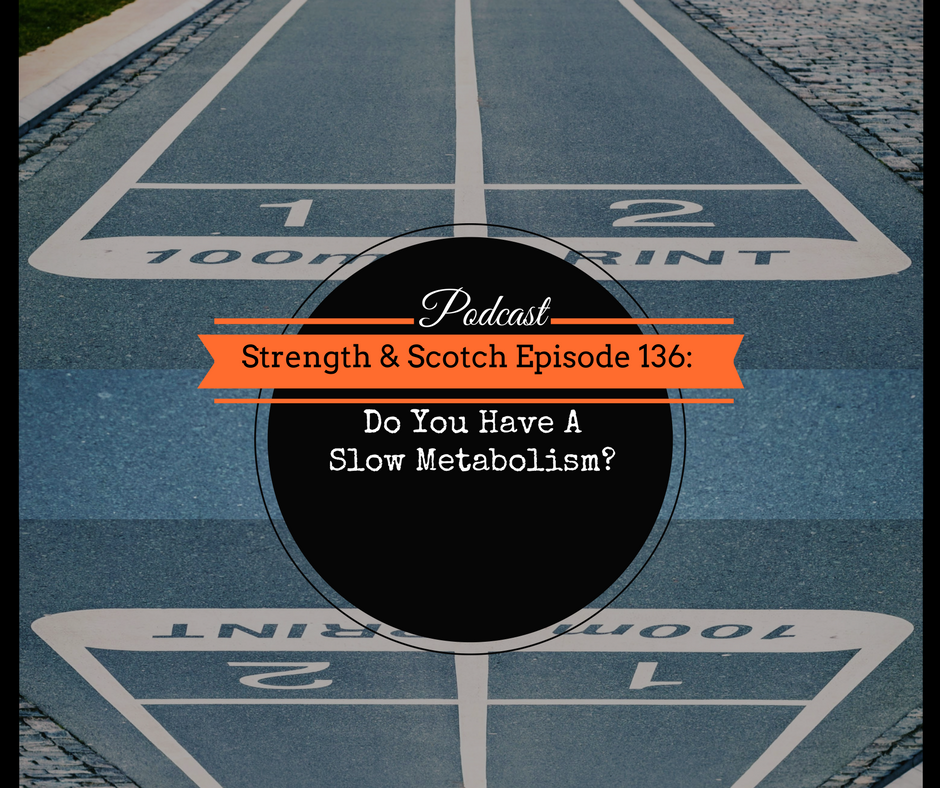SS 136 – Do You Have A Slow Metabolism?
Episode 136 Show Notes
Grant and Heavey take a dive into metabolism and the different factors that cause it to slow down. Do you feel like you’re no longer burning calories as much as you used to? Then you probably blame it on your metabolism slowing down. Listen in to better understand how this whole thing actually works!
[00:33] A Reunion of the Two
Heavey just actually finished a drive halfway across the country to visit Grant and while he was driving, he stopped by to see his in-laws. It was 120 degrees and planes couldn’t take off. Grant explains it’s because smaller, regional airports don’t have long enough runways and with the thinner air, it takes more distance for planes to get up to speed or they have to go faster to create the lift. With shorter runways local airports have, planes couldn’t achieve that.
Another reason Heavey is in town is to attend a two-day Arroyo Seco music festival in Pasadena, California. They’re looking forward to an exciting lineup of artists including Live, Weezer, Tom Petty, Mumford & Sons, Alabama Shakes, and more.
[04:15] Grant Has a Broken Skull
On a different note, it was previously mentioned that Grant thought he broke his nose from playing basketball and it actually ended up that he broke his maxilla bone which is part of the skull, specifically that part between your nose and your teeth. Grant got a couple of fractures there and he messed up the cartilage. As it got worse, his upper lips started to swell and his teeth hurt.
A little backstory, Grant broke his bone on a Sunday, went to the ER the following Saturday, and on the seventh day (Sunday), he had a doubleheader scheduled for basketball. Unfortunately, he committed to it knowing how difficult it is for their team to get filled up and despite the discouragement he got from his mom and girlfriend, he decided to play anyway. And so he actually played while wearing this crazy face mask.
What’s worse for Grant was the fact it was a doubleheader when he’s not in the best shape of his life right now. One game is bad enough and it’s brutal with back-to-back games.
[07:45] Epsom Salt Bath
Considering Grant has struggled with soreness for years and with his face hurting, good thing he listened to his girlfriend’s advice to do an Epsom salt bath. So when he went back home, he loaded his tub with Epsom salt and soaked himself in it. He played for two hours straight but he didn’t even feel like he had played basketball the next day. They didn’t have a substitute player so he never sat down for the doubleheader. Grant says this has changed the way he looks at recovery and he recommends doing some Epsom salt bath if you’re dealing with muscle soreness or DOMS. He swears by it!
[11:26] Slower Metabolism
Most people complain about their metabolism slowing down as they get older. This is considered an inevitability for most people. This episode is pretty similar with their discussion back in episode 96 (Calories In vs. Calories Out) but from a different angle.
The number of calories you burn in a day is known as your Total Daily Energy Expenditure or TDEE, which is composed of three factors: 1. Resting metabolic rate (RMR), 2. Thermic effect of the food you eat, 3. Activity factor.
The resting metabolic rate is generally what people refer to as their “metabolism” which is the amount of energy your body burns at rest. So when people say they’re metabolism isn’t what it used to be, they’re referring to this RMR number.
[13:45] Calories In, Calories Out
Heavey says that the food we eat can affect the number of calories we burn as well as our satiety from those food. This could also account for the changes which you see from people as they get older. As you get older and get busier, you go to more “convenience” food.
Grant thinks people don’t really think about their resting metabolic rate when they’re complaining about metabolism. Rather, they could be thinking that they end up absorbing more calories from the food they eat. Heavey explains the idea of it is that somehow they’re not burning as many calories. Their body has this number of calories it burns but it’s not burning as much as it used to.
[15:15] Should We Blame It On the RMR?
The resting metabolic rate or RMR accounts for 70% of this whole number of calories the body burns on a daily basis. But Heavey points out that 96% of people are within 16% of one another, as far as their RMR’s go, relative to their height, weight, and age. Heavey found this study that measured RMR across a wide range of population and it didn’t show a huge amount of variation among individuals, maybe, at most, just 200-300 calories between different people.
For example, take all 43-year-old males that are 6’8″ and 400 pounds, and the biggest range is 16%. While 18-year-old females that are 5’3″ and 110 pounds only have 16% difference. So there’s not a lot of variation in the number. Heavey adds that even if it’s a little over 300 calories, it’s still not that much. That said, it’s an excuse people use when it’s really not that big.
[18:28] Bigger Brain, Bigger Fat-Free Mass, Higher RMR
They’ve also done this research on people that have higher RMR like the people who are burning extra 300 calories in a day but they’ve found that it’s not predictive of future weight gain. Instead, they found that if you have a higher RMR, you’re going to be eating an extra 300 more calories to account for it. Hence, it’s just balances your body since you feel the need for having more calories so your body convinces you to eat.
Heavey explains that RMR is mostly determined by your fat-free mass. The brain and visceral organs only account for about 12% of your fat-free mass but they’re highly metabolically active and they burn 200-440 calories per kilogram per day. So this probably explains why Heavey is super lean because he considers himself to have a massive head.
[20:00] More Muscle Mass, More Calories Burned
Scaling the muscle mass is a big contributor to the amount of calories you burn. This is another reason people say their metabolism is not as good as it used to be because you got older, you got less active, and you lost muscle. Muscle mass burns about 13 calories per kilogram per day at rest whereas a fat tissue burns about 4.5 calories per kilogram per day, which is about three times more.
There is this idea of sarcopenia where muscle mass starts declining over time. Hormone-wise, there are shifts in people that make it more challenging for them to build muscles but it’s not impossible to build muscle. Plus, you can do things like eat adequate protein and lift to preserve your muscle mass over time. But if you’re not actively trying to do that, it’s bad news and it’s a big contributor to why people think they’re not burning as many calories as they used to. RMR can slow as you age which is usually due to loss in muscle mass.
[21:33] Gut Bacteria and RMR
Newer research, although not conclusive, also suggests that gut bacteria can actually influence RMR. The microbiome is an emerging field of research so a lot of stuff are coming out. However, there’s not much deep understanding of this research yet.
[22:19] RMR and Maintaining Internal Temperature
Heavey says the biggest thing that has the greatest influence on RMR is maintaining the temperature level in your body. Cooling yourself and forcing your body to respond by warming yourself up have been attributed to increased fat loss. About two-thirds of the body’s RMR is required for maintaining internal temperature. Grant and Heavey actually discussed this concept back in Episode 129. When you’re cold, you tend to eat more so there’s a compensatory mechanism there. To increase your body temperature by one degree can actually increase your RMR by over 10%.
[24:00] Thermic Effect of Food
This refers to the amount of energy required to digest, absorb, assimilate, and store the nutrients from the food you eat. While the RMR accounts for roughly 70% of your total daily energy expenditure, the thermic effect is about 10% of your TDEE. This varies largely based on your macronutrient content. Carbs require about 5%-10% of the calories you consume, fats require 0-3%, and protein requires 20-30%. This is one reason why when Heavey is working with clients on weight loss, they focus their food intake on protein. Not only is it the most satiating macronutrient, but you burn a ton of calories by eating them. Heavey further says there are so many reasons to prioritize protein. It protects your muscle and it protects your “metabolism” which actually means it keeps your RMR elevated.
[26:30] The Activity Factor
Heavey refers to the activity factor as the most variable component of total daily energy expenditure. It can be as low as 15% in super sedentary people and as high as 50% in really active people. The activity factor includes two groups, one is physical activity (exercise) and the other is non-exercise activity thermogenesis (NEAT). NEAT is the energy that powers you for doing like when you’re fidgeting or doing random walking that is not intentional exercise.
[28:39] Age as a Factor
Grant presents this scenario to Heavey: Take two males with the same height and weight but 20 years apart. Heavey explains that statistically, they’re going to have a lot less muscle mass when they’re older. Whether age is a factor in slowing down metabolism, there is either a correlation or causation piece to it. We notice people substantially losing muscle mass as they age because people are not taking care of themselves.
[30:00] Increasing Your RMR
There’s a few things you can do to help improve your RMR. Increasing your muscle mass increases your RMR. Doing anaerobic activities (ex. intervals, sprints) can lead to post-exercise oxygen consumption which is this whole idea of the afterburn effect wherein you’re not just burning calories when you’re exercising but even after the exercise which can last for a period of 24 hours or so. You can then add this to your training program if it’s part of your goal. Alongside, these activities help stimulate muscle growth more strongly than aerobic activities. This can reinforce your cycle of maintaining your muscle mass and keeping your RMR more elevated. Even when you’re not building muscle, when you exercise and damage your muscles, it requires energy to repair them.
Just a side note here but it actually hurts Heavey when people say improve your “metabolism” because it’s not really an accurate depiction of what’s happening but it’s the way people refer to it.
[31:45] Decreasing Your Body Temp
Decreasing your body temperature is another way for you to increase your RMR. Some people have this notion that if you want to burn more calories and get your metabolism firing, you need to eat every two hours throughout the day or eat six meals. This is 100% crap. There is no research that backs this up at all.
Another way to increase your RMR is to increase your NEAT and this is what you’re probably hearing all the time. Take the stairs. Get up from your desk and walk every hour. Stand from your desk.
[33:15] When RMR Decreases: Adaptive Thermogenesis
Meanwhile, there are a few interesting pieces to decreasing your RMR. What you want to do is prevent it from decreasing and a major contributor to decreasing your RMR is eating less than your total daily energy expenditure. If you are eating a caloric deficit to diet, your body gets pissed and plays nature’s trick on you and it drops your RMR. One of the ways to tell this is if your motivation to move is decreased. It’s something you don’t necessarily recognize happening but it makes you tired.
By eating at a deficit, you’re actually decreasing your energy expenditure by 5%-15%. This concept is known as adaptive thermogenesis and it’s one of the reasons that when people are eating at a deficit, they will add in maybe one day per week where they jump their calorie intake back up. People call this a cheat day but you don’t necessarily eat relentlessly, it just means eating more food that day where you push things back up and let your body recognize that you’re not going to starve.
When you do this well, after your dieting, your body should be able to restore its RMR. Super extreme dieting can be very damaging to your RMR so you want to really be very careful about dieting and not going that extreme route otherwise it could mess you up for a lifetime. The next time anybody out there says their metabolism is just not what it used to be and says it in a way that it’s the way life is, tell them to lift.
[37:00] Let’s Talk Scotch!
In celebration of Grant and Heavey’s face-to-face reunion, Grant took out a bottle of Ardbeg Corryvreckan and Heavey describes his experience drinking it as his soul trying to escape his body. Heavey’s favorite is an Ardbeg Uigeadail.
Heavey’s actually not used to using a Glencairn glass and because of the shape, he tried to take a sip and accidentally took a gulp. Imagine taking a gulp of a 57% alcohol. Nevertheless he liked it and it does feel stronger than a Uigeadail.
Grant says that when you think of a spirit, it’s always 40%. Jumping up to 50% is quite a big difference and going up to 57% is yet another jump. So there’s nothing wrong with adding a little bit of water to it. The way you get from 57% to 40% is not because that the stuff that comes out of the barrel is different but it’s because they add water to it. That said, it’s nice to try something at its full strength.
Grant personally likes the flavor. He says it has a lot of alcohol and a lot of heat but it’s soft on the nose. Heavey likes it too but he also wants to try adding a splash of water in it. Still, he prefers the Uigeadail. Grant finds it sweeter than Uigeadail.
p
Links:
Check out the gear page for everything Strength & Scotch! You’ll find a listing of all the supplements and other programs we’ve discussed on the show as well as our killer t-shirts!


